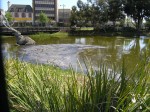The Columbian Mammoth
(Mammuthus columbi)
The Columbian Mammoth was the largest mammal to have been trapped in the La Brea Tar Pits. Some individuals stood over 13 feet tall. The mammoth migrated into North America from Asia about 2 million years ago. The Columbian Mammoth was larger, but less hairy, than the wooly mammoth which lived near the ice sheets in the northern end of the continent
|
Dire Wolf (Canis dirus)
The dire wolf was a very close relative of the timber wolf and may have hunted in packs of 3-20 animals. The dire wolf may have been able to bring down bison or camel.
|
American Lion
(Felis atrox)
The American lion was probably the most formidable predator of its time. It was larger than the Indian tiger, the African lion or the California Saber-tooth. Shown in this display one American lion and one California Saber-tooth.
|
California Saber-tooth (Smilodon californicus)
The California Saber-tooth probably ambushed the larger and slower animals such as ground sloths and young mammoths or mastodons. California Saber-tooth were first discovered in the 19th century in a Brazilian cave deposit and are known to have ranged throughout the western hemisphere.
|










